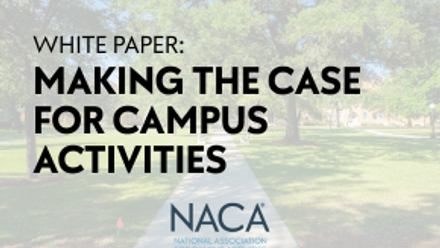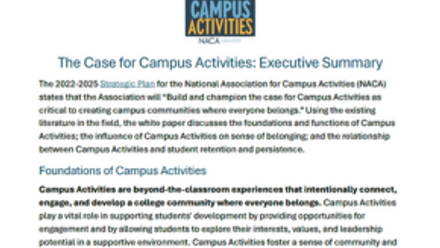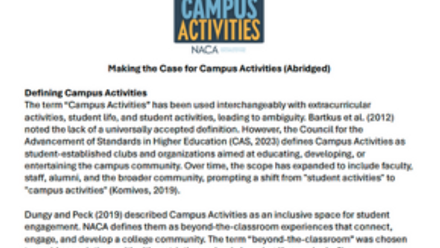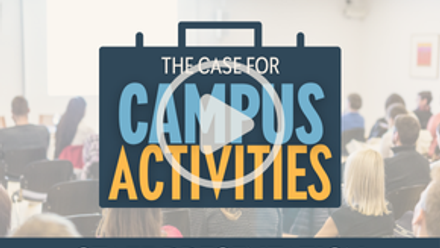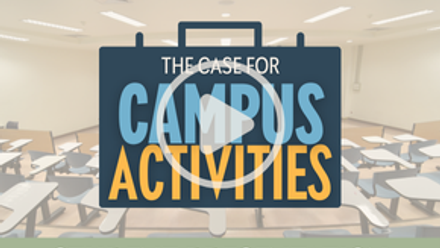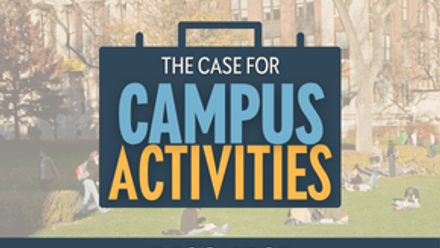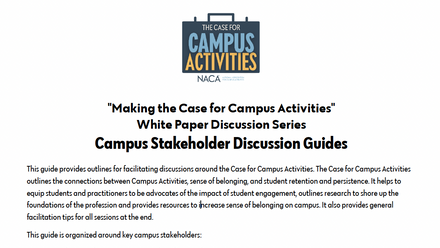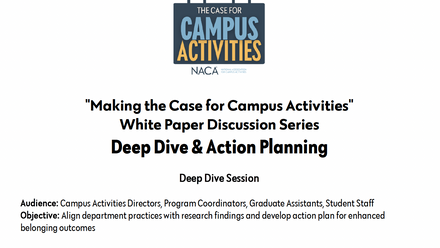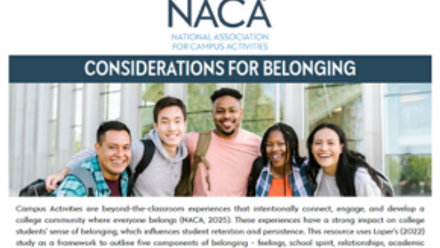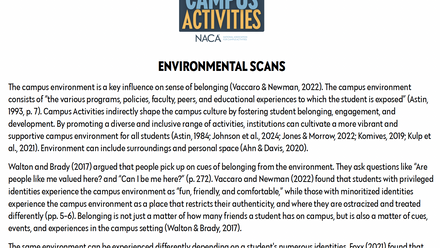The Case for Campus Activities

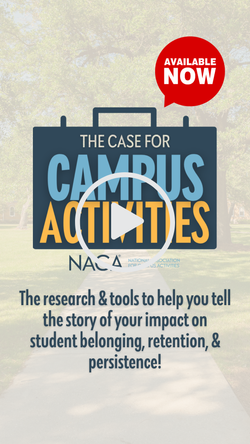
The 2022-2025 Strategic Plan for the National Association for Campus Activities (NACA) states that the Association will “Build and champion the case for Campus Activities as critical to creating campus communities where everyone belongs” (2022). First, we defined Campus Activities as beyond-the-classroom experiences that intentionally connect, engage, and develop a college community where everyone belongs. Through this work, we posit that Campus Activities are intentional experiences and not specific functional areas.
The Case for Campus Activities outlines the connections between Campus Activities, sense of belonging, and student retention and persistence. It helps to equip students and practitioners to be advocates of the impact of student engagement, highlights research to shore up the foundations of the profession, and provides resources to increase sense of belonging on campus. Here are a few key takeaways:
- Campus Activities Build Belonging. Whether it is a welcome week concert or a quiet craft night, Campus Activities programming creates spaces where students feel connected, affirmed, and "at home."
- Engagement Supports Retention & Persistence. Students who are involved, whether actively or passively, are more likely to stay enrolled and complete their degrees.
- Diverse Involvement Matters. Providing a mix of active and passive programming can cultivate a more vibrant and supportive campus environment for all students.
- Relationships and Environment are Critical. Campus Activities programming creates spaces where students feel valued, affirmed, and connected to peers and staff, which is especially critical for underrepresented students.
- Your Story Deserves to Be Told. The research calls on Campus Activities professionals to track, measure, and share how their programs impact students. This is your chance to make your case. How Are You Using the Case? Let Us Know! Share your experiences with us. Email us at [email protected] or tag @theNACA #MakingtheCase #CampusActivities
The more a student engages with and is involved on campus, the more they learn and develop. Further, institutional effectiveness is proportional to the capacity for fostering that involvement (Astin, 1984). As outlined in the Making the Case for Campus Activities white paper, Campus Activities increase sense of belonging and, in turn, sense of belonging increases student and institutional success. When a student feels like they belong, they are more likely to remain at the institution. Campus Activities offer opportunities for various student groups to feel engaged and integrated into their college community.
As the higher education landscape changes (almost daily!) budgets are reconsidered, structures are reviewed, and staff are rearranged. Campus Activities professionals may find themselves forced to justify their budgets, programs, or even their existence.
In this challenging environment, the “fun” that campus activities work brings to campus may seem superfluous. That is why it is essential for campus activities professionals to connect to our higher purpose – and communicate that with clarity to others. (Peck, et al., 2020, p. 6).
The Case for Campus Activities can help you communicate the purpose of Campus Activities.
Astin, A.W. (1984). Student involvement: A development theory for higher education. Journal of College Student Development, 40(5), 518-529.
NACA membership is required to access the Case for Campus Activities
- The Making the Case for Campus Activities white paper provides an academic foundation that outlines the connections between Campus Activities, sense of belonging, and retention and persistence by discussing:
- The Foundations of Campus Activities
- Sense of Belonging
- The Influence of Campus Activities on Sense of Belonging
- The Influence of Campus Activities on Retention and Persistence
- A recorded presentation and a slide deck for professional staff outlining the connections between Campus Activities, sense of belonging, and retention and persistence.
- A recorded presentation and a slide deck for students, outlining the connections between Campus Activities and sense of belonging and the role students play in fostering a sense of belonging.
- Considerations for Belonging resource
- Environmental Scan resource
- Discussion Guides for various campus stakeholders to talk about the white paper
- Deep Dive & Action Planning resource for Campus Activities departments
- More to come!
How can I use the provided resources to make the case for Campus Activities on my own campus?
- White paper
- Share with upper administrators
- Include in onboarding resources for new staff
- Read as a staff and discuss
- Think about how you can affect change on environment, involvement, and relationships to increase belonging on campus
- Presentations/slide decks
- Watch and discuss the presentation for staff at a staff meeting
- Use the slide deck to make your own presentation to upper administration
- Watch the student presentation as part of student organization training
- Watch and discuss the student presentation at a meeting
- Use the slide deck to make your own presentation to students
- Encourage students to use the slide deck to present to peers or upper administration
- Resources
- Use the Discussion Series Guides to facilitate discussions around belonging across campus
- Complete an environmental scan
- Use the Considerations for Belonging resources to design events with belonging in mind
How Are You Using the Case? Let Us Know!
Share your experiences with us. Tag @theNACA #MakingtheCase #CampusActivities

